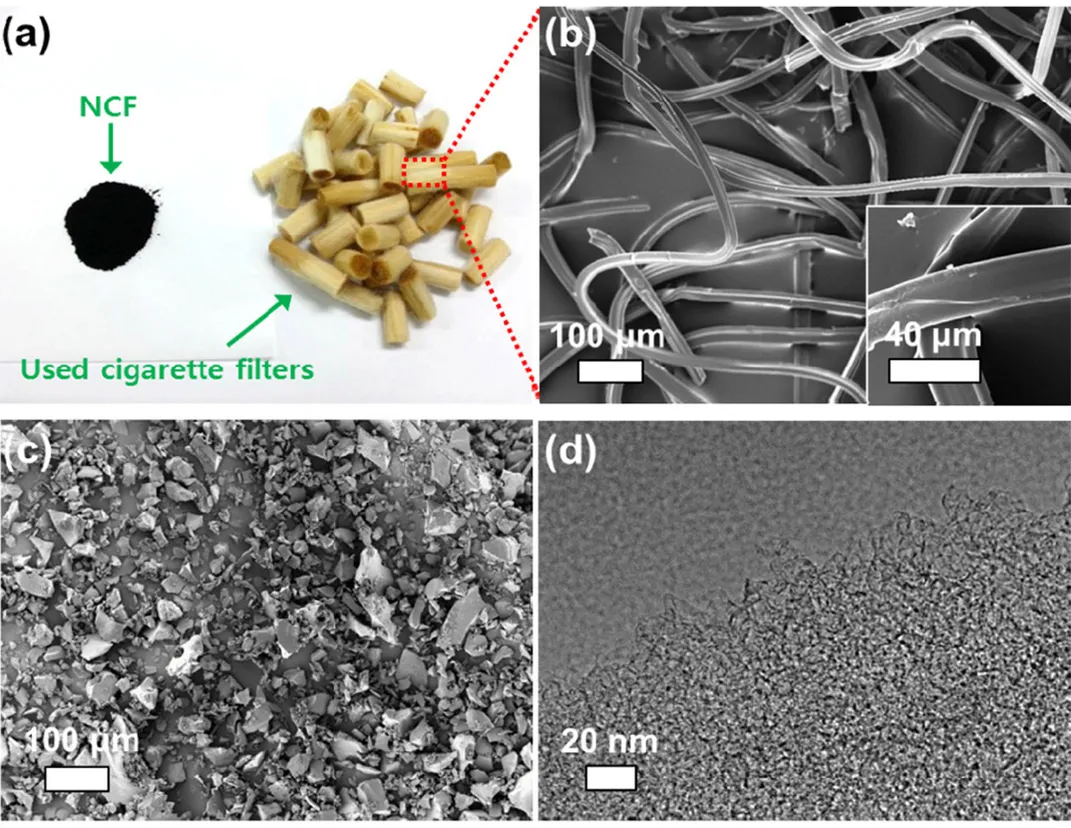Cigarette Butts Could Help Power Future Devices
South Korean researchers have found a simple way to turn toxic trash into high-performance supercapacitors
/https://tf-cmsv2-smithsonianmag-media.s3.amazonaws.com/filer/9f/ca/9fca68ed-c6ab-49bb-abe0-aede8178c958/cigarette-butts.jpg)
With more than a billion smokers worldwide, according to the World Health Organization, tobacco use isn’t just a health problem, but a major environmental issue as well. Trillions of cigarette butts a year get tossed out, often on the ground, where they cause fires, get ingested by animals and leach chemicals into the ground and water.
A group of South Korean researchers at the Environmental Material & Process Lab at Seoul National University have found a way to transform cigarette butts from harmful waste to a boon for green energy initiatives.
In a recent paper in the journal Nanotechnology, the researchers demonstrated a one-step process for turning used cigarette filters (the main component of butts) into a material that can be used to store energy in supercapacitors—components that can be used alongside batteries in the electrical grid, consumer electronics and electric vehicles.
Supercapacitors excel at delivering a swift power boost when needed (say, when you hit the accelerator in an electric car, or during peak hours in an electrical grid), taking stress off the battery, which is better at delivering a constant flow.

According to the paper, when subjected to chemical decomposition in a technique called pyrolysis, the cellulose acetate fibers in the filters convert to a carbon material with varying-sized pores and a large surface area. This makes the material ideal for energy storage in supercapacitors, because the ions need a physical surface to cling to. According to the authors, the butt-based material outperforms substances currently being used in supercapacitors, like carbon, graphene and carbon nanotubes.
Minzae Lee, one of the paper’s authors, says that because the South Korean government is considering raising tobacco taxes, cigarettes were on many people's minds. But he says it was Gil-Pyo Kim, one of his co-authors, who first came up with this idea.
“There is already numerous research [showing] that carbon material can be synthesized by pyrolysis of plastic material,” Lee writes. “So we expected that the transformation of cigarette butts into an energy storage material might be a solution to two human-challenging issues, environmental and energy problems.”
The process of turning used butts into superconductor material does require a fair amount of energy, however. Lee says the temperature of the filter material needs to be increased 5 degrees per minute in an oxygen-free environment, until a maximum temperature of 900 degrees Celsius is reached. Then, the material is kept at this temperature for two hours. This process is similar to how wood is made into charcoal.
Once created, the researchers coated an electrode with their material, rather than the activated carbon used in traditional supercapacitors, and tested its ability to charge and discharge by absorbing and releasing electrolyte ions.
According to the paper, the material derived from used filters was able to charge and discharge faster, as well as hold more electrical charge, than traditional materials. The material was able to maintain this performance through 6,000 charge and discharge cycles during testing.
Elon Musk, founder of Tesla Motors, stated in 2011 that a supercapacitor breakthrough will be important for the future of electric vehicles. But don’t expect future plug-in cars to forego batteries altogether. It’s the supercapacitors’ ability to very quickly absorb massive amounts of power when a vehicle brakes that makes them a good fit for EVs. The traditional batteries would then slowly absorb that electricity back into their cells, where it could be used to extend the vehicle’s range. It’s unlikely that supercapacitors will approach the storage abilities of chemical-based batteries any time soon.
“Supercapacitors are used in applications which require fast charging/discharging, while batteries are used for the larger amounts of energy,” writes Lee. “Supercapacitors should be loaded in electronic devices simultaneously with the use of batteries.”
As this method for improving supercapacitors is still in the testing phase, it’s unclear when the team’s recycled cigarette material will find its way into vehicles or other devices. But it’s clear that when the time does come to ramp up production, there will be no shortage of cigarette butts available to build billions of supercapacitors.
/https://tf-cmsv2-smithsonianmag-media.s3.amazonaws.com/accounts/headshot/unnamed.jpg)
/https://tf-cmsv2-smithsonianmag-media.s3.amazonaws.com/accounts/headshot/unnamed.jpg)